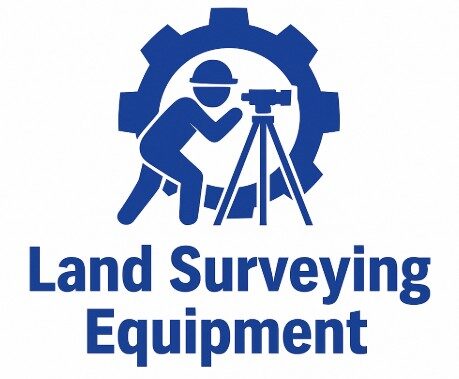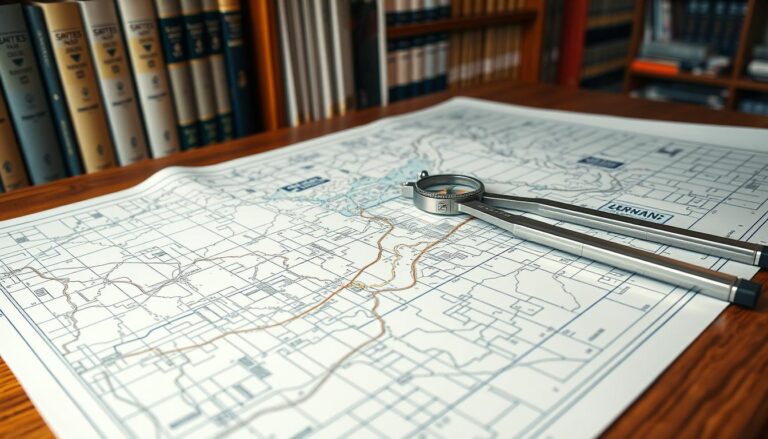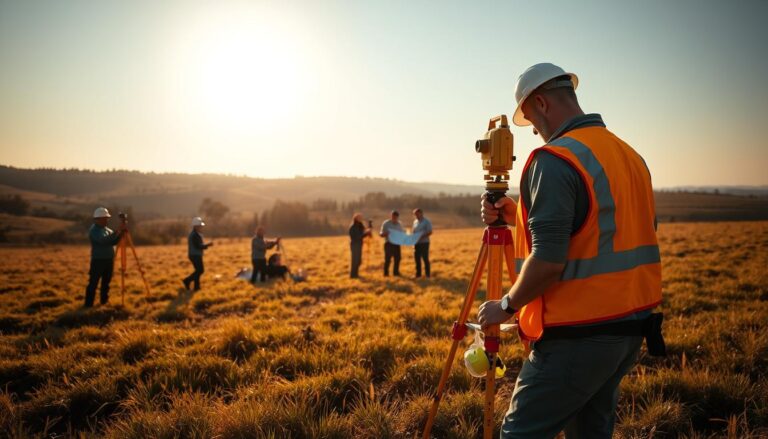Boundary Disputes and Encroachments: What You Need to Know
Property owners often face big challenges with boundary disputes and encroachments. These issues can cause legal problems and emotional stress. It’s key to know the basics of property boundaries.
Dealing with property boundary disputes is complex. It involves legal and emotional sides. Owners need to know their rights and the risks of ignoring encroachments.
It’s important to understand the difference between what clients expect and what’s legally possible. Knowing when to get a lawyer is also crucial. The stress of dealing with upset neighbors over property lines is real.
Surveyors live in a world most people don’t understand – a world where inches spark lawsuits and fences spark feuds. One wrong call can lead to years of courtroom drama (and no Christmas cards from your neighbors). This guide lays out what really happens when property lines go sideways – and how professional surveyors handle the minefield that is boundary disputes, encroachments, and neighborly “misunderstandings.”
Key Takeaways
- Understanding property boundaries is crucial for avoiding legal complications.
- Boundary disputes can lead to significant emotional distress for property owners.
- Knowing when to involve legal counsel is key to resolving disputes.
- Managing client expectations versus legal realities is essential.
- Dealing with angry neighbors requires a thoughtful approach.
The Fundamentals of Property Boundaries
Property boundaries are key to solving land boundary conflicts. They are not just lines on a map. They are legal limits that show where one’s property ends and another’s begins.
To get these boundaries, we need to know how they are set. Legal definitions of property lines come from history, surveys, and property deeds.
Legal Definitions of Property Lines
Property lines are defined by property deeds and surveys. These can use metes and bounds or the Public Land Survey System (PLSS). Metes and bounds give details with reference points. The PLSS divides land into squares.
Knowing these definitions helps spot issues that could cause property line disputes. For example, unclear descriptions can confuse where boundaries are.
How Boundaries Are Established
Boundaries are set through surveys and legal documents like deeds. Land surveyors are key in this. They measure and mark lines based on legal descriptions and history.
Setting boundaries is more than just a technical task. It’s crucial for avoiding disputes with neighbors and preventing encroachments.
The Difference Between Boundaries and Monuments
It’s important to know the difference between boundaries and monuments. Boundaries are the legal limits of a property. Monuments are physical signs that show where these limits are.
Monuments can be natural, like trees, or artificial, like iron pins. But, they don’t define the boundary. They just show where it is supposed to be.
If there’s a mismatch between a boundary’s legal description and the physical markers, solving it needs careful analysis. Often, a land surveyor or legal expert is needed.
Common Types of Boundary Disputes and Encroachments
It’s important to know about common boundary disputes and encroachments. These issues can come from different sources. They can affect property owners a lot.
Structural Encroachments
Structural encroachments happen when structures go beyond property lines. These can include:
Buildings and Additions
When a building or an addition crosses the property line, it’s a big issue. This can happen because of misunderstandings or during renovations.
Fences and Walls
Fences and walls often cause disputes. If they’re built too far, they can upset neighbors. The type of material, height, and location add to the problem.
Non-Structural Encroachments
Not all encroachments are physical. Non-structural encroachments are things that aren’t buildings but still affect property rights.
Trees and Vegetation
Branches or roots from trees can cross into another property. This can cause fights over who should take care of them and who is responsible for damage.
Utility Lines and Easements
Utility lines like electricity, water, or gas can also be a problem. If they cross property lines without permission or easements, it’s an encroachment.
Access and Right-of-Way Disputes
Disputes over access and right-of-way are common. They happen when people disagree about paths or roads across property lines. Clear agreements and documented easements help avoid these issues.
Knowing about these boundary disputes and encroachments is crucial. Property owners need to understand their rights and the laws about property lines. This helps them deal with these complex problems.
Legal Framework Governing Property Line Conflicts
The laws about property line disputes are complex. They vary by state and have many rules. Property owners need to understand these laws to solve boundary issues.
State-Specific Property Laws
Property laws change from state to state. It’s important to know the laws in your area. For example, some states use a rectangular survey system, while others use a metes and bounds system.
Key aspects of state-specific property laws include:
- Boundary determination methods
- Procedures for resolving encroachments
- Laws governing adverse possession
- Regulations regarding easements and rights-of-way
Adverse Possession Principles
Adverse possession is a legal rule. It lets someone own a property if they use it openly and against the true owner’s wishes for a certain time. This time varies by state.
The key elements of adverse possession include:
- Actual possession of the property
- Open and notorious use
- Exclusive possession
- Hostile or adverse claim
- Continuous possession for the statutory period
Prescriptive Easements
A prescriptive easement is a right to use someone else’s property. It’s gained through long, uninterrupted use. Unlike adverse possession, it doesn’t give ownership but allows specific use.
Statutory Remedies
Statutory remedies help property owners deal with boundary disputes. They can get injunctions, damages, or other compensation. Knowing these remedies is key to solving property line issues.
Some common statutory remedies include:
- Injunctive relief to stop encroachments
- Monetary damages for losses incurred
- Boundary line adjustments through agreement or litigation
The Critical Role of Land Surveyors
In the complex world of property boundary disputes, land surveyors are key. They use modern survey techniques and historical records. Their work is crucial in resolving encroachment issues and property boundary disputes.
Land surveyors use various methods to find property boundaries accurately. These include:
- GPS technology for precise location data
- Total Station measurements for detailed topographic surveys
- 3D scanning for comprehensive site analysis
Modern Survey Methodologies
Advanced technologies have made land surveys more accurate and efficient. For example, expert boundary survey tips are very helpful in complex disputes.
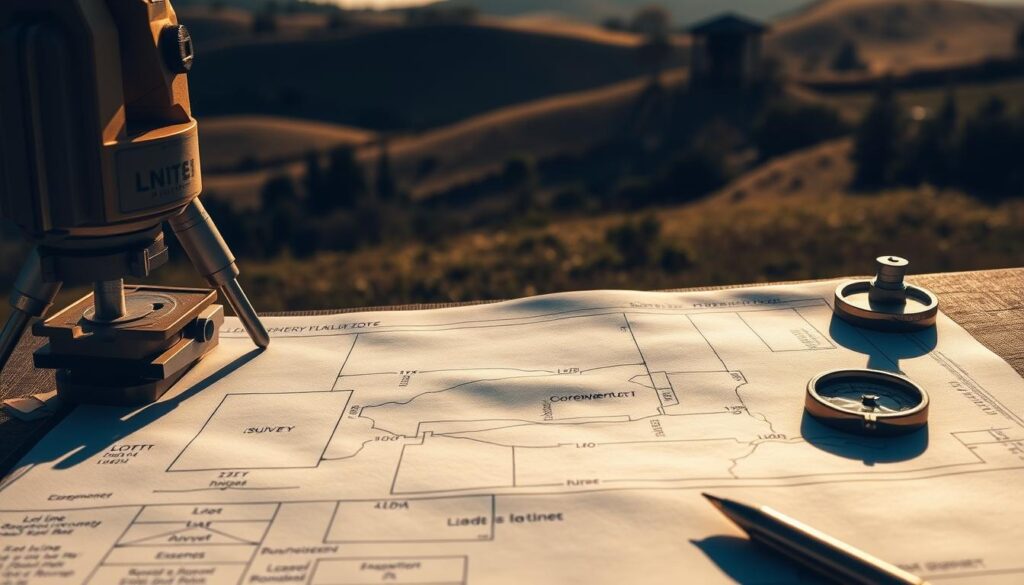
Interpreting Historical Records and Monuments
Land surveyors use both modern tech and historical data. Historical records and monuments are key to understanding property boundaries. They help solve boundary disputes.
Old maps, deeds, and other documents are important. They show the original boundaries. Monuments, whether natural or man-made, mark these boundaries.
Limitations of Survey Evidence
Land surveyors are vital in solving boundary disputes, but there are limits. The condition of monuments, past survey accuracy, and land use changes can affect survey evidence.
Knowing these limits is key to handling property boundary disputes well. It helps find fair solutions for all parties.
Navigating Client Expectations vs. Legal Realities
The gap between what clients expect and what the law says about land boundaries can be tough to close. Clients often think they know more about their property rights than they actually do. This can lead to misunderstandings about boundary disputes and encroachments.
Talking clearly with clients is crucial. They need to understand the legal side of their property rights and the chance of disputes.
Common Misconceptions About Property Rights
Many clients think their property goes beyond what’s marked. But, boundary disputes and encroachments often happen because property lines are unclear or in dispute.
For example, a client might think a fence or hedge marks their boundary. But, it could actually be on their neighbor’s land. It’s important to clear up these misunderstandings to avoid future problems.
Communicating Technical Information to Clients
Land surveyors are key in explaining complex information to clients. They need to make it simple, so clients understand the survey’s findings.
Using simple language and visual tools like maps and diagrams helps. This way, clients can get the technical details of land boundary conflicts. It’s vital for managing their expectations and avoiding confusion.
Managing Disappointment When Surveys Contradict Assumptions
When surveys show something different from what clients thought, it can upset them. Surveyors must be ready to explain things clearly and guide clients on what to do next.
It’s important to stick to the law, even if it’s not what clients want. Surveyors can help clients deal with boundary disputes and encroachments. This way, they find a solution that follows the law and respects property rights.
When Surveyors Should Recommend Legal Counsel
Property line disputes can get out of hand fast. Surveyors need to know when to tell clients to get a lawyer. They act as a neutral third party, spotting issues and helping clients through the process.
Warning Signs of Escalating Disputes
Surveyors should watch for signs that a dispute is getting worse. These include:
- Increasing tension between neighbors
- Threats of lawsuits or aggressive actions
- Disagreements over property lines or rights
If these signs show up, surveyors should tell clients to get legal help to protect their rights.
Documentation Practices for Potential Litigation
Good documentation is key when facing a lawsuit. Surveyors should keep detailed records of:
- All letters and talks with clients and neighbors
- Survey results and how they were done
- Any problems or disputes that come up during the survey
Keeping good records helps surveyors provide strong evidence for their clients’ cases.
The Surveyor as Expert Witness
Surveyors might be asked to be expert witnesses in property line disputes. To get ready, they should:
- Know their survey methods and findings well
- Be able to explain complex stuff simply
- Give fair, unbiased opinions based on their knowledge
As expert witnesses, surveyors can help clients deal with tough property issues.
The Emotional Side of Property Lines
Boundary disputes are not just about laws and rules. They touch on our feelings and how we see our space. It’s key to understand this emotional side to solve disputes peacefully and help clients through tough times.
Understanding Territorial Psychology
How we feel about our property is shaped by our psychology. We see our land as a part of us, our identity, and our safety. This makes disputes about property lines very emotional.
Our property is more than just something we own. It’s tied to who we are, our family, and our past. This makes disputes about property lines very emotional.
Dealing with Angry Neighbors
Disputes over property lines can make neighbors angry. It’s important to listen, understand, and talk things out calmly.
De-escalation Techniques
Using techniques to calm down conflicts is key. This includes listening well, staying calm, and looking for solutions that work for everyone. These steps can help reduce tension and find a way forward.
- Listen actively to the neighbor’s concerns
- Stay calm and composed, even in the face of aggression
- Seek common ground and potential solutions
When to Remove Yourself from Confrontations
It’s important to know when to step back from a fight. If things get too heated or scary, it’s best to keep safe and get help from experts or the law if needed.
For more on how property line disputes can lead to legal problems, check out this resource on the legal side of overlooking property lines.
Supporting Clients Through Emotional Disputes
Helping clients through the emotional side of boundary disputes is a big part of the job. It’s not just about giving legal advice but also about offering emotional support and understanding.
By recognizing the emotional side of boundary disputes and offering the right support, professionals can help clients get through these tough times more smoothly.
Practical Resolution Strategies
To solve boundary disputes, it’s key to look at different ways to fix them. This includes mediation and making agreements about the boundary. Legal fights over property lines can be tough and emotional. But, with the right method, they can be solved well.
Negotiation and Mediation Approaches
Negotiation and mediation are often the first steps in solving boundary disputes. These methods let parties talk and find a solution they both agree on. Mediation, in particular, is great because it uses a neutral third party to help find common ground.
The good things about negotiation and mediation are:
- They save money compared to going to court
- They solve problems faster
- They help keep good relations with neighbors
- They offer the chance to find creative solutions
Boundary Line Agreements and Easements
Sometimes, boundary line agreements or easements are needed to solve disputes. A boundary line agreement is a legal document that clearly shows the property line. An easement lets one party use another’s property for a specific reason.
These agreements are useful when:
- There’s a disagreement about where the property line is
- One party needs to get to their property through another’s land
- A utility company needs to get to a part of a property
Cost-Benefit Analysis of Different Solutions
When dealing with boundary disputes, it’s important to look at the costs and benefits of each solution. This means comparing the costs of negotiation, mediation, and going to court to the benefits.
Doing a detailed analysis helps parties make smart choices. It lets them pick the best way to solve their problem.
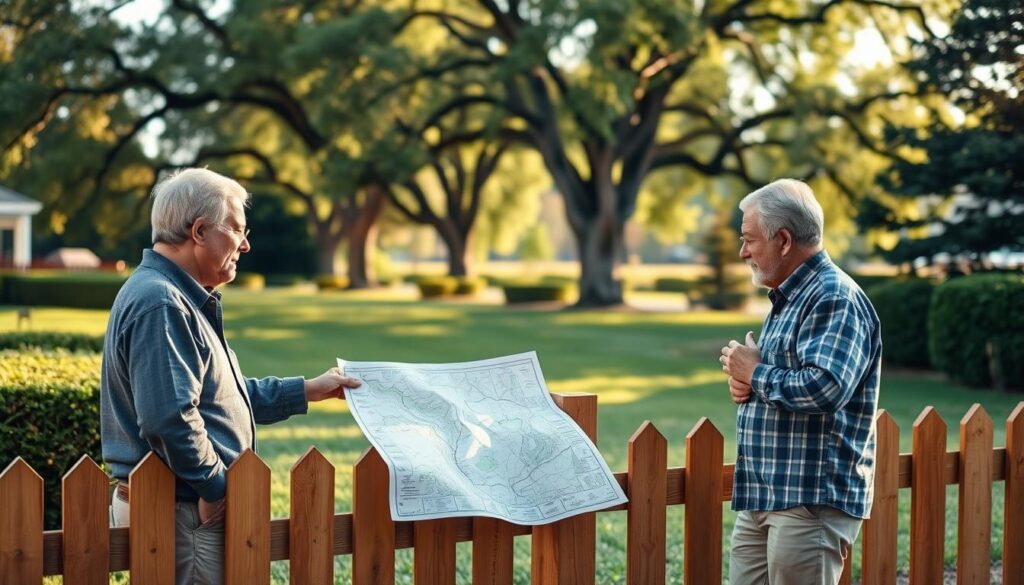
Conclusion
Knowing about property boundary disputes and encroachments is key for homeowners and landowners. This knowledge helps avoid legal problems. We’ve covered the basics of property boundaries, common disputes, and the laws that apply.
Disputes over boundaries and encroachments can cause big financial losses and hurt relationships with neighbors. Land surveyors play a big role in solving these issues. They help figure out the exact boundaries and guide on what to do next.
Good ways to solve these problems include talking things out, mediation, and making agreements about the boundary lines. By understanding these complex issues, people can handle them better and find peaceful solutions. It’s important to tackle these problems early to keep property values up and enjoy your property in peace.
